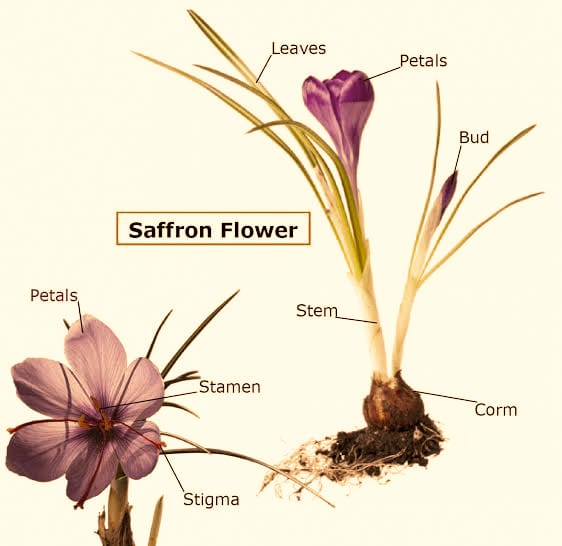
Answer
467.1k+ views
Hint: Crocus sativus, commonly known as saffron crocus, or autumn crocus, is a species of flowering plant of the Crocus genus in the iris family Iridaceae. The saffron spice is obtained from the parts of the flower that constitute its pistil.
Complete answer:
Saffron is an expensive spice derived from the blueish purple flowers of Crocus sativus. It has vibrant crimson colored stigma and styles, which are called threads. These threads are collected and dried. They are mainly used as a seasoning and coloring agent in food. The domesticated saffron that is unknown in the wild is the crocus. The Crocus sativus is an autumn-flowering perennial plant.



Additional Information:
The iodoform-like or hay-like, taste and fragrance, of Saffron result from the phytochemicals picrocrocin and safranal. The rich golden-yellow hue to dishes and textiles are added by the presence of the carotenoid pigment, crocin.
So, the correct answer is that saffron is obtained from the styles and stigmas of Crocus.
Note:
1) Crocus sativus is a sterile triploid form. It means that three homologous sets of chromosomes make up each specimen's genetic complement.
2) It bears eight chromosomal bodies per set, making for 24 in total.
3) Since it is sterile, the purple flowers fail to produce viable seeds and so reproduction takes place through clusters of corms which are underground bulb-like starch-storing organs.
Complete answer:
Saffron is an expensive spice derived from the blueish purple flowers of Crocus sativus. It has vibrant crimson colored stigma and styles, which are called threads. These threads are collected and dried. They are mainly used as a seasoning and coloring agent in food. The domesticated saffron that is unknown in the wild is the crocus. The Crocus sativus is an autumn-flowering perennial plant.



Additional Information:
The iodoform-like or hay-like, taste and fragrance, of Saffron result from the phytochemicals picrocrocin and safranal. The rich golden-yellow hue to dishes and textiles are added by the presence of the carotenoid pigment, crocin.
So, the correct answer is that saffron is obtained from the styles and stigmas of Crocus.
Note:
1) Crocus sativus is a sterile triploid form. It means that three homologous sets of chromosomes make up each specimen's genetic complement.
2) It bears eight chromosomal bodies per set, making for 24 in total.
3) Since it is sterile, the purple flowers fail to produce viable seeds and so reproduction takes place through clusters of corms which are underground bulb-like starch-storing organs.
Recently Updated Pages
Who among the following was the religious guru of class 7 social science CBSE

what is the correct chronological order of the following class 10 social science CBSE

Which of the following was not the actual cause for class 10 social science CBSE

Which of the following statements is not correct A class 10 social science CBSE

Which of the following leaders was not present in the class 10 social science CBSE

Garampani Sanctuary is located at A Diphu Assam B Gangtok class 10 social science CBSE

Trending doubts
Which are the Top 10 Largest Countries of the World?

Fill the blanks with the suitable prepositions 1 The class 9 english CBSE

How do you graph the function fx 4x class 9 maths CBSE

Give 10 examples for herbs , shrubs , climbers , creepers

Change the following sentences into negative and interrogative class 10 english CBSE

Difference between Prokaryotic cell and Eukaryotic class 11 biology CBSE

The Equation xxx + 2 is Satisfied when x is Equal to Class 10 Maths

Write a letter to the principal requesting him to grant class 10 english CBSE

What organs are located on the left side of your body class 11 biology CBSE




